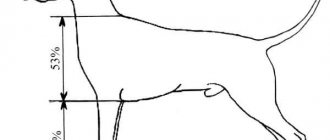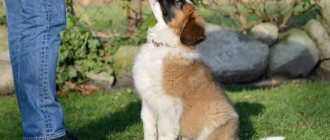Labrador personality
The dog is kind, loyal, smart, easy to get along with, perfectly trainable with a high level of intelligence. She loves children, gets along well with other animals, and is affectionate with people.
The fearless dog often works as a rescue dog. She has excellent intuition, and this quality is used all over the world. The Labrador has more than once saved the lives of epileptics, anticipating the onset of an attack before the owner. Noticing the dog’s anxiety, the owner takes the necessary medications on time. This breed is an excellent swimmer, and due to the water-repellent undercoat, the animal can even be in icy water.
The dog is very energetic, so walks with it are always active and joyful. In order for the dog to get tired and run around, the owner needs to throw a ball/plate/run together while walking, or even better, find a company so that several dogs can frolic together. If the pet does not run, it will continue to do so at home.
Maintenance and care
Labrador requires special care and maintenance. The owner is required not only to feed, drink and walk with the animal. It is necessary to correctly prepare the diet so that the calorie content does not exceed the norm, otherwise, instead of a living and healthy dog, a barking “pig” - an overfed one - will barely move around the house.
In addition, calories should be spent on a walk. It should be long, active and intense. The duration of one walk is at least 20 minutes. This breed needs to run, a lot!
Even though dogs have short hair, it should be brushed. This procedure will not only help remove old dead hairs, but will also increase blood flow, which will lead to accelerated growth of new hairs. Don’t forget about regular examinations: eyes, ears, nose, teeth, skin. And don’t forget about the veterinarian, as well as preventive deworming and vaccinations.
Be sure to educate your dog! He is an excellent learner, so as soon as the baby appears in the house, immediately begin training. The dog should not run to strangers and fawn (but aggression is not allowed), eat from the ground or from someone else’s hands, and ignore the owner’s commands.
Labrador and types of barking
ALARM/WARNING BARK
Dogs that bark at mail carriers, joggers passing by the house, or cyclists on the street have natural support for their barking. They see the postman, they bark, and the postman leaves. The dog thinks: “I’m great. My barking made the man leave.” When changing this behavior, we need to overcome this support.
Sometimes simply preventing the dog from seeing the mailman approaching can solve the problem. However, we often need to work harder. First, we need to make sure that we do not reward the dog for any type of barking.
If a dog barks when he wants to eat and we feed him, then we are encouraging vocalization. If we try to ignore the barking but eventually give in and pay attention, the dog learns that barking for a short time has no effect, but excessive barking for a long time does.
After the dog alerts us to an intruder, we need a way to signal to the dog that he's good for alerting us, but then we'll take control. The "Enough" command will help you achieve this goal.
Remember: you are unintentionally encouraging barking by providing verbal or physical encouragement to a barking dog.
To teach your dog the “No more” command, set up a situation in which your puppy will bark but not excessively, such as knocking on the door. After one bark or two, stop banging and make a sound that will draw his attention to you. If he stops barking, immediately say “That's enough” and reward him with a treat and praise.
If he doesn't stop barking, bring the treat directly to his nose. When he stops barking for a second or two, say “That's enough,” wait a couple more seconds, and if he sits quietly, give him a treat and praise.
The most important thing is timing. He must remain quiet when you give him a treat, otherwise he will think he is being rewarded for continuing to bark. Make sure you say the word “Enough” when he is silent, not when he is barking. Later, when he associates the command “No more” with silence, you can use it to stop the barking.
SCARED BARKING
Some dogs may start out with alarm or warning barks, but then progress to barks associated with fear. One of the most common examples of this is dogs barking at approaching strangers.
If your dog is barking because he is afraid of people, he first needs to learn to be obedient, submissive and relaxed. You can then start with situations where people approach from afar, and as your dog remains calm, you give him a treat. Over long periods of time (days or even weeks), people should only approach her to the point where she remains calm and you can encourage her.
As people begin to get even closer, have them throw treats in her direction, so she will begin to associate people with something good. During this long, supervised workout, it's best to avoid situations where you have no control, such as walking down a busy street.
Don't encourage your puppy to bark at people. This can develop into a bad habit and he may begin to be suspicious of people and even afraid of them. There is a chance that he will bark at random situations or strangers without your permission.
LABRADOR BARKING TO GET ATTENTION
Young puppies, as well as adults, will soon learn that barking gets our attention. The problem is that dogs will appreciate any attention they receive, be it positive or negative. A strict “No” from you is also attention, so the puppy will get what he wants, and you will reinforce his behavior. It is best to ignore this type of barking, no matter how difficult it may be.
Sometimes the use of remote correction can be helpful in controlling this type of barking. Coins in an empty soda can, whistles, or other noise sources can be used to startle a dog when it barks.
When she is scared, she stops barking. At this point, you can provide her with a replacement for barking - give her a toy or take her for a walk. Just make sure she stops barking before you give her a replacement, otherwise the dog will see it as a reward for barking.
PLAY/EXCITABLE BARKING
If your dog barks excessively during play, it is best to let him calm down or slow down the play. If she continues to bark, stop playing until she calms down.
IDENTIFIABLE LABRADOR BARKING
This type of barking is primarily instinctive and can sometimes be difficult to control, especially in a home with many dogs. Often one dog is the instigator and the others join in. This type of barking can be controlled using the same approach as alarm/warning barking, i.e. using subjugation and calming techniques, and offering replacement behaviors such as toys.
LABRADOR BARKING FROM BOREDOM
Dogs that bark when they are bored may be attention-seeking dogs or dogs feeling lonely. Dogs that are bored need something to do other than bark. We need to provide them with a more stimulating environment, and usually more physical activity. A tired dog is less likely to become bored. Toys filled with treats will help your dog's brain and body function.
LONELY/WORRIED BARKING
Dogs that bark when they are alone may be displaying a symptom of separation anxiety. As we have already pointed out, these dogs are in the middle of a vicious circle - the more lonely they are, the more they bark, the more upset they become, the more they bark, barking makes them more upset and they bark even more - and so on. circle.
We need to work on the dog's behavior that is underlying separation anxiety. We can do this in several ways. As with alarm/warning barking, we must be able to teach the dog simple obedience and how to relax. Then we work on the problem of separation anxiety.
Start by leaving (or pretending to leave) for a short period of time - and returning before the dog becomes nervous and barks (this may be one second at first). This way we don't encourage barking, but we do encourage relaxation and silence.
We gradually increase the time we leave and return before the dog becomes nervous. If your dog is nervous even when you leave the room, you need to start by walking a few steps away from him while he remains calm. When going through this behavior modification, you can't go too slow—you can only go too fast.
Often we also need to change our own habits. Often the dog becomes nervous when we regularly leave the house. Maybe you're like me, and the last thing you do before leaving is put on your shoes and grab your keys. Change it up: take your keys and put on your shoes, but don't leave. Sit on a chair and read a book.
If you only turn on the radio on weekends when you're at home, turn it on during your weekdays. As hard as it may be, set an alarm on weekend mornings, get up, but stay home. Repeat these changes constantly until the dog stops paying attention to your cues to leave. It is very important not to give your dog too much attention when you leave.
When you leave, make sure your dog is comfortable - light, warm, radio on, toys nearby. If your dog lives outside, a kennel will make him feel more secure. Some indoor dogs will be happier if they can watch what's going on outside, be it traffic or squirrels running by. Others may be even more anxious if they can look outside and feel better with the curtains closed. Make sure you provide your dog with plenty of physical activity for at least half an hour before you leave. As with boredom, tired dogs are less likely to be restless.
If your dog is prone to not only barking, but also breaking and chewing things while you're away, he may need a dog crate. Never punish your dog if you come home and find something chewed or torn. If you do this, your dog will soon begin to associate your coming with punishment. This, in turn, will make her even more anxious.
If you videotape the destructive behavior of these dogs, you may notice that the dog is anxious when the owner leaves, but anxiety also increases before the time the owner usually returns home, at which point the dog becomes anxious about the owner's impending return and punishment.
You shouldn't punish your dog when you return, but you also shouldn't give him a lot of attention so that your return home won't be a special occasion for him. Instead, walk in, say “Hi!”, and get on with your homework. Once your dog has calmed down and calmed down, you can spend time with him.
When starting to work on behavior modification, it may be helpful to ask a neighbor or pet sitter to come over one or more times during the day. This will help break up the long hours your dog waits for you.
Finally, if separation anxiety is severe, medication is often necessary during the behavior modification process. Medications alone will not solve the problem, but they can be a helpful addition to the process. Consult your veterinarian to determine which medication is most appropriate.
SCARED BARKING
The best way to deal with fearful barking is to use the same technique as for alarm/warning barking.
Teaching the command “No more” will greatly help in this situation. If a certain sound consistently scares your dog, record the sound. Start by playing it very quietly so your dog can remain calm when he hears it. If she remains calm, reward her. Over the course of days and weeks, gradually increase the volume of the sound until she becomes scared and barks when she hears it.
PATHOLOGICAL BARKING
Normal annoying barking is no comparison to pathologically excessive barking. Most of the types of barking we've discussed are normal behavior, with the exception of barking that occurs due to separation anxiety.
Barking may be abnormal or "pathological" in situations like separation anxiety, as a result of obsessive-obsessive disorder in which the dog barks too much or barks at inappropriate things (falling leaves), or in dogs that become overly excited when people approach or other dogs.
Dogs that become aggressive during barking episodes must go through aggressive behavior modification before we attempt to change the barking behavior.
For dogs with abnormal barking or additional behavior problems, a team approach to the problem is strongly recommended. The team consists of all family members, an animal behaviorist and a veterinarian. Each family member should interact with the dog in the same ways, using the same commands, and the behaviorist should be able to identify your dog's unique behavioral characteristics and help you create training situations that will be most effective.
Your veterinarian may also be able to give you some insight as well as prescribe appropriate medications to allow your dog to be more responsive to behavior modification.
Features of the breed: pros and cons
Pros:
- An affectionate breed of dog. An ideal pet for those who have kids at home. The Labrador gets along well with them, one might even say that they are an excellent nanny. You can safely leave a child with a well-mannered dog: the dog will not harm him, even if the baby plays dentist or horseman.
- The smartest dog. Training her is not only easy, but also pleasant, because the Labrador picks up everything on the fly. If everything is in order with the animal’s psyche (and if you take it from good breeders, and not scammers who do not disdain inbreeding), then very quickly a well-mannered and obedient dog will grow out of a little fidget.
- Versatility. It is expressed not only in the fact that the Labrador is an excellent nanny for children, but with proper training, the dog can be a guide, become a rescuer or a service dog (how many Labradors work at customs or search for people at disaster sites). If the owner tries, then this breed can become guard dogs, but, most importantly, teach that strangers are not those who need to lick their hands and let them into the house. But thanks to the high level of intelligence, the Labrador will master any “profession”.
Minuses:
- Excessive affection, and not only towards the owners. Strangers to the dog also lick themselves from head to toe. This makes the Labrador not the best guard dog. Too affectionate dog breed.
- Ready to eat all day long. Often and a lot, and if the owner does not monitor this, then health problems definitely cannot be avoided. And on the street you should be careful, and it is better to put a muzzle on the dog, otherwise your Labrador will destroy everything edible from the ground, like a vacuum cleaner. You definitely need to train your pet, and then the barking cutie won’t eat anything.
Why does a Labrador puppy bite?
reasons why a Labrador attacks and bites . As a rule, this breed is very friendly and not aggressive. They will try to avoid the conflict in any way; they will never be the first to fight. Therefore, most often the problem that a Labrador bites is associated with play moments.
Why is this happening? The answer is quite difficult. The reason may be:
- Passion for the game. In their natural environment with their fellow animals, biting during play is a common practice. Yes, in principle, it is thanks to their sharp teeth that puppies begin to explore the world. All instincts inherent in nature are connected precisely with this process. First, the Labrador growls , then the puppy bites his brothers and, if he hears a piercing squeak from his friend, he understands that he has caused pain. As a rule, next time the bite will be much weaker, or the baby will completely refuse to taste the brothers. This happens in the same way during a game with the hosts. But it’s up to you whether you will support such fun. Don’t forget, the little lump will soon get stronger, and the teeth will change from baby teeth to permanent ones, and then the bites will be much more painful.
- Cruelty. Cruelty shown to a puppy can give rise to feelings of aggression in it. Physical punishment has a negative impact on the psycho-emotional health of a pet. an aggressive Labrador appears , which is not friendly either to people or to other dogs.
- Complexity of character. Although Labradors are a problem-free breed, each individual is individual. Sometimes the animal tries to subjugate family members with the help of bites and take a leading position. In this case, the dog's authority will have to be earned. Labrador aggression is associated with individual characteristics and requires immediate intervention and behavior correction.
- Lack of education. Dogs who are allowed literally everything from early childhood grow up spoiled and disobedient. The little Labrador barks on the street and at home , bites the hands and feet of the owners , the Labrador jumps on people, and in response there is tenderness and pats in the palm of the hand. Of course, with this line of behavior you will not grow up to be an angry Labrador , but you will have a willful and uncontrollable pet, to whom you will have to adapt.
These are the main reasons why Labrador barking and biting may occur. How to deal with this, and is it possible to rehabilitate a dog?










